Land dispute divides Brazil’s north
Al Jazeera’s Gabriel Elizondo looks at a court’s ruling over indigenous land and its impact.
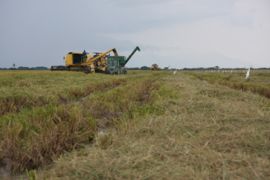
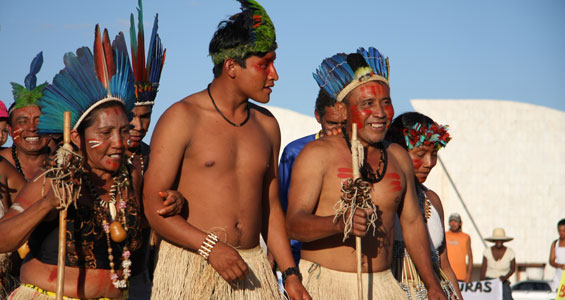 |
| Indigenous people outside the Supreme Court in Brasilia, Brazil’s capital, have been waiting for a final ruling [MARIA HELENA ROMERO] |
Brazil’s Supreme Court is to deliver a decision in a land dispute case that is being called one of the most important rulings in the country’s history because of the long-term impact it will have on indigenous peoples.
The case revolves around Raposa Serra do Sol, a territory which is home to 19,000 indigenous people comprising four tribes in the northernmost Brazilian state of Roraima, situated between Venezuela and Guyana.
Keep reading
list of 4 itemsWorld’s coral reefs face global bleaching crisis
Why is Germany maintaining economic ties with China?
Australia’s Great Barrier Reef suffers worst bleaching on record
In 2005, Luis Inacio Lula da Silva, the Brazilian president, demarcated the million-hectare land as indigenous territory.
However, a small but powerful and well-connected group of rice farmers who have ranches inside the federally-recognised indigenous territory have refused to leave the demarcated area.
Led by Paulo Cesar Quartiero, the biggest rice grower in the region, the farmers have refused to give up what they say is their rightful claim to the land. Rice from his farm feeds two million Brazilians, he says, and he has been on the land for 30 years.
“We are only defending our rights as Brazilians, and citizens, workers, producers,” Quartiero told Al Jazeera. “We have the obligation to defend our interests.”
This has led to a tense and often bloody standoff with the indigenous people who want them off their land.
The indigenous people say that now that the land is federally designated as theirs, the rice farmers must obey the law and leave.
“Our land is our mother – we have our parents and grandparents buried here, that is why we are fighting,” Eneisa Maria de Lima, a Macuxi Indian said.
Powerful connections
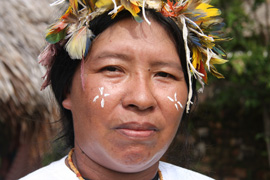 |
| De Lima says the Macuxi Indians are fighting for ancestral homes[MARIA HELENA ROMERO] |
The rice farmers have powerful connections. Quartiero is not only a rice farmer but also the mayor of neighbouring Pacaraima, a town of 9,000 along the border with Venezuela.
A part of the municipality of the town lies inside of Raposa Serra do Sol.
Jose de Anchieta Junior, the governor of Roraima, supports the rice growers saying the consolidation of indigenous land restricts economic progress in his state.
He appealed against the demarcation of the indigenous land and asked for the Federal Courts to re-reconsider a ruling that would allow the rice growers to stay, essentially allowing “islands” of rice farms within Raposa Serra do Sol.
“First, a great part of the area of our state is committed to indigenous land, and if this goes through, 47 per cent of our state will then be demarcated for the Indians, and this endangers our economic development,” Anchieta Junior told Al Jazeera.
“And also, this land is a border area with Venezuela and Guyana so it is a national security and sovereignty issue,” he added shortly after meeting with James Anaya, the UN special rapporteur on indigenous rights who was paying a visit to Brazil to access the overall situation in the country.
Many believe the Supreme Court’s ruling is the final arbitrated decision on the matter and therefore cannot be appealed.
Anchieta Junior, the governor, said he will respect whatever decision is handed down.
Bloody battles
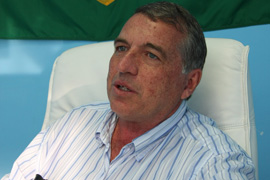 |
| Quartiero has taken armed measures to prevent his eviction [MARIA HELENA ROMERO] |
But the rice growers claim it is the Indians who have powerful connections with outside interests, namely foreign NGOs, who they claim want to gain some control of the Amazon.
“The internationalisation of the Amazon has begun, and it has begun here in Roraima,” Quartiero claims.
Quartiero has violently opposed being forced off his farm by the federal government. When the federal police were sent to the area, bridges leading to his farm were set on fire allegedly on his orders to block access.
Earlier this year, armed men working on Quartiero’s farm opened fire on indigenous people, wounding several. Home video of the incident was widely distributed by a network of indigenous rights activists. Quartiero was arrested, but he claims the Indians tried to occupy his land and his men were simply defending it against attack.
Over the past few months, Quartiero has dug in – a huge piece of farming equipment blocks the main entrance to his ranch, which sits several kilometres off the main dirt road running through Raposa Serra do Sol.
He has spoken openly about defending his land at all costs and has voiced his disdain for the federal police.
Potential for violence
Over 200 heavily armed federal policemen are being sent to the region in anticipation of possible violence after the Supreme Court verdict.
During an interview with Al Jazeera in his office, Quartiero was asked if he was worried about violence breaking out if the Court ruled against him.
“My only worry is what will happen if (the Federal Government) comes to take my land away from me,” he said, without offering any more details.
Quartiero is widely supported in the state by people who consider him to be a defender of non-indigenous peoples’ territorial rights. His supporters also believe that the indigenous Indians in the area already have too much land.
The total area of the indigenous demarcated land is 1.7 million hectares. The total area of all the rice farms inside Raposa Serra do Sol is about 30,000 hectares.
And both sides in this battle concede that there are indigenous people who publicly support the rice growers, but their number is difficult to determine. The indigenous people attribute this divide to different political views within a family.
Bigger land disputes
Supporters of indigenous rights say Brazil’s rapid rate of development necessitates the allotment of land for indigenous peoples.
According to FUNAI, the government agency that oversees indigenous people in Brazil, the country is home to about one million Indians. They come from 220 different indigenous groups that speak more than 180 languages.
Indian land accounts for about 12 per cent of Brazil’s territory. Last year 92 Indians were killed in land disputes.
“We have a situation of conflict in Brazil with respect to indigenous lands,” said Marcio Meira, FUNAI’s president.
“Indigenous lands are located in regions where the economic expansion in the form of agriculture and cattle ranching is happening. Indigenous lands are also being disputed by infrastructure projects like roads and dams,” he told Al Jazeera from his office in Brasilia.
Long-term implications
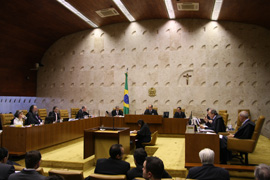 |
| The Supreme Court’s decision is expected on August 28 [MARIA HELENA ROMERO] |
The Supreme Court ruling is expected to have major implications, no matter who wins.
Should the Court rule in favour of the State of Roraima and the rice growers, many observers feel that ownership of more federally-recognised indigenous territory inside Brazil – and other countries – could then be challenged in the courts.
“If they rule against the Indians, it will have a devastating effect because this could create a legal exception that would threaten other indigenous land in Brazil,” Meira said.
“And it could have an effect internationally, because many countries look to Brazil as a model of a country that defends the land rights of indigenous peoples; so many people outside Brazil are watching this decision closely.”
If the Supreme Court rules in favour of the Indians, many farmers in Brazil who have land near Indian areas fear their property could be at risk and there is a fear of violence.
The Indians say they are in it for the long fight no matter what the outcome.
“Our children want to move freely in this land – to hunt and fish and that is why we will continue to fight until the last Indian,” said Eneisa Maria de Lima of the Macuxi tribe.